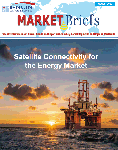Interview with Jean Michel Rouylou, Head of Enterprise Market, ST Engineering iDirect
Herndon, Va., August 18, 2022--To shed light on the role that satellite technology plays in the energy markets, Satellite Markets and Research Editor-in-Chief Virgil Labrador spoke with Jean Michel Rouylou, Head of Enterprise Market, ST Engineering iDirect.
What are service providers to the energy sector looking for in ST Engineering iDirect’s products?

We offer a portfolio that is aimed at addressing the key needs of the oil and gas and energy sectors. Above everything else, they are looking for products that are extremely reliable. The energy environment is mission critical and therefore they are looking for products that offer very high MTBF (mean time between failure). Both our Evolution and Dialog platforms offer this high reliability.
Another key requirement is high availability. We consistently drive efficiencies using higher MODCODs and using better waveforms. This way, we can achieve 99.99% availability even in bands such as Ku. It’s very important to gain that level of performance in Ku- because the oil and gas and energy sectors mainly use C-band, but there is less and less available capacity and it is more expensive, so customers are increasingly moving to Ku and Ka. Utilizing our Dialog and Evolution platforms means that they can make this transition easily, and we can offer the same availability and reliability that the end customer so badly needs. We can address the needs of our customers’ end customers, no matter what they require with no need to migrate to new platforms.
The other key point is related to the performance and efficiency of our system. Our technology enables us to deliver more bits per hertz, giving our customers a competitive advantage and resulting in lower recurring costs.
This is a key driver for our customers and a prime reason for switching to our platforms.
In a nutshell, the key benefits that we bring to our customers in the energy industry to enable their success are reliability, availability, efficiency and performance. I would also add that customer support is of very high importance, and this is something that we place heavy emphasis on. Our customers receive all the support they require throughout the lifecycle of their chosen products.
What are the main market trends that you are currently seeing in the energy market and how is ST Engineering iDirect responding to these trends?
Today, the oil and gas world is moving in a new digital direction as it begins to embrace new processes through automation and digitalization, increasing remote control and proactive remote maintenance of assets. Players are increasingly placing applications into the cloud, so ensuring cloud access from the most remote places on earth is imperative. At ST Engineering we are working with Cloud Service Providers (CSPs) and have started to move towards a more cloud-based architecture, where we are virtualizing our hub processing and baseband equipment to deploy it in private or public cloud. We are also building a cloud-based NMS in order to interoperate with other orchestration systems running in the cloud. On the modem side, we have embarked on a partnership with Microsoft Azure with the goal of deploying our virtualized modem on a Microsoft Azure HCI Stack-based solution.
Digitalization of the applications is a major one as well. Although the oil and gas sector has always been a big user of satellite technology, and big data, there’s been a light bulb moment occur within the community that has revealed the real potential of digitalization. In order to move on it, it means investment, but this investment can yield incredible results that have a transformative effect, increasing uptime, reducing service and maintenance costs, optimizing oil recovery, enabling faster detection of failure in production or distribution sites and optimization of all the assets.
You say they need increasing amounts of bandwidth but what kind of applications are energy companies using it for? And why do they need more and more bandwidth?
All the applications that they use now run in the cloud. The cloud is extremely efficient on the data center side and extremely inefficient on the networking side. So, in order to have good cloud performances, you need a lot of bandwidth. But this is not slowing down the adoption of the cloud as the savings generated on the data center largely balance the increased cost of bandwidth.
Energy companies also want to carry out more remote operations and more automation. It’s still the beginning, but an interesting feature that I see growing in the future is what they call a digital twin. A digital twin is basically a real time version of the remote asset that is being operated. If it’s a deep offshore drilling ship, then you have a digital representation of that ship using all the data including IoT data that you would gather on that ship via satellite connectivity. Gaining that additional experience on a digital twin is key. The operational simulations by utilizing Artificial Intelligence can help identify problems more quickly. and work through remotely i.e. with real time data collected at the site. To do this, very high bandwidth is required. Satellite can easily accommodate this bandwidth requirement, giving energy companies a reliable and ready source of bandwidth no matter when it is required.
From the ST Engineering iDirect perspective, what are the main challenges and also the main opportunities that you face moving forward?
There is currently so much advancement going on in the industry. The advent of New Space is creating huge opportunities that will see satellite integrate into a wider, hybrid connectivity landscape that will involve different access technologies. This will ensure that the end user has the right technology available to them for the right application at the right time.
5G will be the master of this convergence, and this will see us in the satellite industry moving to adopt terrestrial standards from the telco world and increasing orchestration and virtualization. Soon, the user won’t know whether they are using satellite, cellular or any other terrestrial technology to connect, because it will be seamless. We’re taking our first steps towards a multi- orbit, multi-access, multi-service future – one that will mean further transformation and even simpler connectivity solutions for the oil and gas industry.
This presents both challenges and opportunities as we innovate to ensure that our customers’ investment is constantly protected as we move into a new and exciting era.
And what is the general attitude towards satellite technology within the energy sector?
Satellite is a critical part of the energy connectivity portfolio. It’s essential because without it, there is no connectivity. The locations of these businesses are geographically dispersed and often remote. Of course, fiber when available is often preferred. But there are examples where laying down fiber lines can be very expensive, i.e. in the North Sea or Gulf of Mexico.
There are many places where satellite remains the best option such as Angola, the Ivory Coast or Nigeria.
The cost of satellite technology has fallen considerably over recent years and companies can reap the huge advantages that it offers them. They can provide connectivity wherever it is needed. It doesn’t matter how remote the site is, satellite can meet the requirement. Satellite also offers very flexible bandwidth, allowing companies to send huge amounts of data over a secure connection and to move to lower bandwidth at quieter times.
Service Providers are well versed in these benefits, and this is why satellite is still a critical part of any energy company’s portfolio of communications.
Is the market now in a bounceback phase?
After almost seven years of downturn from the beginning of 2015 the industry is booming again. Our customers are extremely focused on this business, and this means that they will need a quick response time, cost-effectiveness and proactive support. We are ready and geared up for this rebound activity. We are prepared for the demands that our customers will place upon us. After a period where the investment was just not being made, the sector is now being invigorated. And we are ready to respond.
What about the green energy opportunity? Does this present a sizeable market for satellite?
We are seeing some activity on offshore windfarms where it is challenging to access connectivity or where providers need satellite as a reliable back-up connectivity to collect that data. The vessels that serve the construction and maintenance of new wind farms also rely upon VSAT connectivity to stay connected.
The mining industry will be increasingly important in terms of green energy as renewable machines such as wind turbines and electric cars all require the continual mining and processing of tons upon tons of primary materials, ironically an increased quantity in comparison with hydrocarbons. Therefore, the mining industry will be key in the development of green energy going forward. AT ST Engineering iDirect we have been involved in delivering connectivity to the mining industry for many years. Many companies have now expanded their use of sensors and mobile telemetry to continuously monitor operations, optimize productivity, and improve safety on site. By integrating sensors and data sources over satellite, monitoring of operations and assets can be done remotely, enabling real-time, informed decisions to be safely executed.
Satellite is also essential for the relay of IoT information which is widely used across the green energy sector. IoT is a means to improve productivity, increase efficiencies, and improve safety of personnel. Monitoring of sensors, valves, pumps, motors, and more through human-machine interface (HMI) software and real-time connectivity is crucial as well as basic use cases such as vehicle telematics, real-time analysis of operations and employee tracking for safety and security are also driving IoT growth in this sector. IoT allows security and access control, real-time connectivity in remote locations and enables the remote monitoring of equipment and operations. Wind and solar energy are prime candidates for this type of system and satellite is used to provide the connectivity to move this data back to HQ, where it can be analyzed.
Related Article:
 MarketBrief report on the Energy Market sponsored by ST Engineering iDirect
MarketBrief report on the Energy Market sponsored by ST Engineering iDirect






